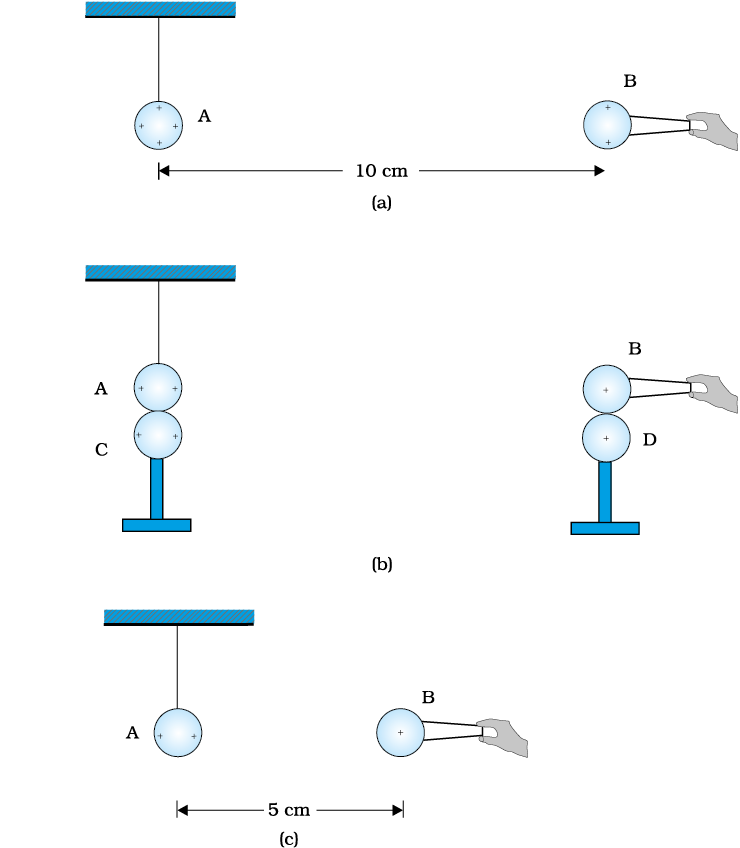| 1. | Charge on any body is quantised. |
| 2. | Charge on any isolated system remains conserved. |
| 3. | Unlike mass, the charge is non-relativistic. |
| 4. | Unlike charged bodies always repel each other. |
Given below are four statements:
| (a) | The total charge of the universe is constant. |
| (b) | The total positive charge of the universe is constant. |
| (c) | The total negative charge of the universe is constant. |
| (d) | The total number of charged particles in the universe is constant. |
Choose the correct option:
| 1. | (a) only | 2. | (b), (c) |
| 3. | (c), (d) | 4. | (a), (d) |
| 1. | \(6.25\times10^{20}\) | 2. | \(1.6\times10^{19}\) |
| 3. | \(6.25\times10^{18}\) | 4. | \(1.6\times10^{-19}\) |
The acceleration of an electron due to the mutual attraction between the electron and a proton when they are \(1.6~\mathring{A}\) apart is:
\(\left(\frac{1}{4 \pi \varepsilon_0}=9 \times 10^9~ \text{Nm}^2 \text{C}^{-2}\right)\)
| 1. | \( 10^{24} ~\text{m/s}^2\) | 2 | \( 10^{23} ~\text{m/s}^2\) |
| 3. | \( 10^{22}~\text{m/s}^2\) | 4. | \( 10^{25} ~\text{m/s}^2\) |

The magnitude of the electrostatic force of attraction between them is:
| 1. | \(\dfrac{1}{3}kq^{2}\) | 2. | \(\dfrac34kq^2\) |
| 3. | \(\dfrac49kq^2\) | 4. | \(\dfrac29kq^2\) |
| 1. | increased by a factor of \(2\) |
| 2. | decreased by a factor of \(2\) |
| 3. | unchanged |
| 4. | increased by a factor of \(4\) |
In the figure given below, two positive charges \(q_2\) and \(q_3\) fixed along the \(y\)-axis, exert a net electric force in the \(+x\text-\)direction on a charge \(q_1\) fixed along the \(x\)-axis. If a positive charge \(Q\) is added at \((x, 0),\) the force on \(q_1\):

| 1. | shall increase along the positive \(x\)-axis. |
| 2. | shall decrease along the positive \(x\)-axis. |
| 3. | shall point along the negative \(x\)-axis. |
| 4. | shall increase but the direction changes because of the intersection of \(Q\) with \(q_2\) and \(q_3\). |
A charged metallic sphere \(A\) is suspended by a nylon thread. Another identical charged metallic sphere \(B\) held by an insulating handle is brought close to \(A\) such that the distance between their centres is \(10\) cm, as shown in Fig.(a). The resulting repulsion of \(A\) is noted. Then spheres \(A\) and \(B\) are touched by identical uncharged spheres \(C\) and \(D\) respectively, as shown in Fig.(b). \(C\) and \(D\) are then removed and \(B\) is brought closer to \(A\) to a distance of \(5.0\) cm between their centres, as shown in Fig. (c). What is the expected repulsion on \(A\) on the basis of Coulomb’s law?

| 1. | Electrostatic force on \(A\) due to \(B\) remains unaltered. |
| 2. | Electrostatic force on \(A\) due to \(B\) becomes double. |
| 3. | Electrostatic force on \(A\) due to \(B\) becomes half. |
| 4. | Can't say. |
1. \(2\) N
2. \(1\) N
3. \(5\) N
4. \(0\) N
Two charges placed in the air at a distance of \(1\) m exert force \(F\) on each other. If these charges are placed inside mica at the same distance, then the new net force between charges is:
| 1. | \(>F\) |
| 2. | \(<F\) |
| 3. | \(=F\) |
| 4. | depends on the area of the slab |




